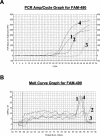Simple Algorithm for Identification of Bordetella pertussis Pertactin Gene Variants
- PMID: 15071014
- PMCID: PMC387558
- DOI: 10.1128/JCM.42.4.1614-1619.2004
Simple Algorithm for Identification of Bordetella pertussis Pertactin Gene Variants
Abstract
Studies performed in several countries have demonstrated the recent emergence and subsequent dominance of circulating Bordetella pertussis strains harboring pertactin and pertussis toxin variants not included in pertussis vaccines. Determination of the pertactin gene variants is commonly performed using a time-consuming and expensive sequence analysis. We developed a simple and reliable pertactin typing algorithm suitable for large-scale screening. The assay correctly identified all pertactin alleles in representative strains. The typing of 231 clinical strains of B. pertussis routinely isolated in Belgium showed that this algorithm was adequate to identify less-frequent prn types like prn9 and prn11.
Figures





References
-
- Andrews, R., A. Herceg, and C. Roberts. 1997. Pertussis notifications in Australia, 1991 to 1997. Commun. Dis. Intell. 21:145-148. - PubMed
-
- Cassiday, P., G. Sanden, K. Heuvelman, F. Mooi, K. M. Bisgard, and T. Popovic. 2000. Polymorphism in Bordetella pertussis pertactin and pertussis toxin virulence factors in the United States, 1935-1999. J. Infect. Dis. 182:1402-1408. - PubMed
-
- De Schutter, I., A. Malfroot, I. Dab, N. Hoebrekx, G. Muyldermans, D. Piérard, and S. Lauwers. 2003. Molecular typing of Bordetella pertussis isolates recovered from Belgian children and their household members. Clin. Infect. Dis. 36:1391-1396. - PubMed
Publication types
MeSH terms
Substances
Associated data
- Actions
- Actions
- Actions
LinkOut - more resources
Full Text Sources

